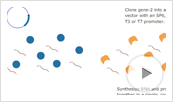Purification of Recombinant Polyhistidine-Tagged Proteins From Mammalian Cells Using the MagneHis™ Protein Purification System
Promega Corporation
Publication Date: 2005
Abstract
We used the MagneHis™ Protein Purification System (Cat.# V8500) to purify two different polyhistidine fusion proteins from transfected CHO cells. The purified MAPK9 and calmodulin polyhistidine fusion proteins were identified by Western blot analysis. We tested two concentrations of G418 for transfection selection. The higher concentration of G418 (500µg/ml) resulted in better selection and more purified protein.
Introduction
The expression of recombinant polyhistidine-tagged proteins in mammalian cells, and their subsequent purification, is becoming more and more common in research laboratories investigating specific protein structure and function. This article describes the successful expression and purification of two polyhistidine-tagged proteins in a mammalian cell line using the MagneHis™ Protein Purification System.
Materials and Methods
Chinese hamster ovary (CHO) cells were transfected with either a CMV-promoter-based mammalian expression vector for polyhistidine-MAPK9 (Mitogen-Activated Protein Kinase 9) or polyhistidine-calmodulin (CAM1) using TransFast™ Transfection Reagent (Cat.# E2431) in a 24-well plate (200µl Opti-MEM® medium, 3µl TransFast™ Reagent, and 0.5µg plasmid DNA per well). Two separate experiments were performed to test different selection conditions. Following transfection (3 days), the cells were incubated with either 100µg/ml or 500µg/ml of G418 to select for those cells that stably express the polyhistidine-tagged protein of interest.
Aliquots of selected cells (2 × 106/ml) from each transfection (including mock-transfected cells) were lysed using 100µl FastBreak™ Cell Lysis Reagent, 10X (Cat.# V8571), with 5µl RQ1 DNase (Cat.# M6101) for 15 minutes at room temperature with shaking. MagneHis™ Ni-Particles (20µl) were then added, and the polyhistidine-tagged proteins were purified as described in Technical Manual #TM060 (1) . An aliquot of each purified sample (13µl) was then separated on a 4–12% Bis-Tris PAGE gel and transferred to Hybond®-C-supported nitrocellulose. The blot was developed using Anti-Penta-His primary antibody (Qiagen), anti-mouse HRP-conjugated secondary antibody, and chemiluminescent detection reagents. The blot was exposed to autoradiography film for 5 minutes.
 Figure 1. Western blot analysis of cell lysates from CHO cells transfected and selected for expression of polyhistidine-MAPK9 (~50kDa) or polyhistidine-CAM1 (~25kDa) proteins.
Figure 1. Western blot analysis of cell lysates from CHO cells transfected and selected for expression of polyhistidine-MAPK9 (~50kDa) or polyhistidine-CAM1 (~25kDa) proteins.
Lane designations: lane 1, mock-transfected cells; lanes 2 and 3, cells transfected with the polyhistidine-MAPK9 expression vector; lanes 4 and 5, cells transfected with the polyhistidine-CAM1 expression vector. Lanes 2 and 4 represent selection with 100µg/ml G418, while lanes 3 and 5 represent selection with 500µg/ml G418.
Results and Conclusions
The results of the expression and subsequent purification of polyhistidine-MAPK9 and polyhistidine-CAM1 from transfected and selected CHO cells are shown in Figure 1. The successful transfection, expression, and purification of polyhistidine-MAPK9 (~50kDa) in CHO cells can be seen in lanes 2 and 3, while the successful transfection, expression, and purification of polyhistidine-CAM1 (~25kDa) can be seen in lanes 4 and 5. A protein of ~60kDa detected in all samples, even the mock-transfected cells, is possibly an endogenous Ni-binding protein that reacts with the Penta-His primary antibody and is seen in elutions from similar purification resins from other vendors. The transfection and selection using 500ug/ml G418 appeared to be more successful for both polyhistidine-MAPK9 and polyhistidine-CAM1 as the intensity of the protein bands is greater (compare lane 2 with lane 3 and lane 4 with lane 5). This results is most likely due to more efficient selection with a higher concentration of G418 selection reagent. The MagneHis™ Protein Purification System is a convenient and efficient system for the purification of polyhistidine-tagged proteins from mammalian cells.
The MagZ™ Protein Purification System (Cat.#V8830) can also be used for the purification of polyhistidine-tagged proteins from mammalian cells using FastBreak™ Cell Lysis Reagent, but the ~60kDa background protein copurifies with this system as well (data not shown). For the MagZ™ system, the purification protocol is similar to the MagneHis™ Protein Purification System, except that 40µl MagZ™ Binding Particles are used and the washing steps are performed using the MagZ™ Binding/Wash Buffer.
Related Products
How to Cite This Article
Scientific Style and Format, 7th edition, 2006
Betz, N. Purification of Recombinant Polyhistidine-Tagged Proteins From Mammalian Cell Using the MagneHis™ Protein Purification System . [Internet] 2005. [cited: year, month, date]. Available from: https://www.promega.com/es-es/resources/pubhub/enotes/purification-of-recombinant-polyhistidine-tagged-proteins-from-mammalian-cells/
American Medical Association, Manual of Style, 10th edition, 2007
Betz, N. Purification of Recombinant Polyhistidine-Tagged Proteins From Mammalian Cell Using the MagneHis™ Protein Purification System . Promega Corporation Web site. https://www.promega.com/es-es/resources/pubhub/enotes/purification-of-recombinant-polyhistidine-tagged-proteins-from-mammalian-cells/ Updated 2005. Accessed Month Day, Year.
Products may be covered by pending or issued patents or may have certain limitations on use. Please visit our patent and trademark web page for more information.
Hybond is a registered trademark of Amersham Biosciences, Ltd. Opti-MEM is a registered trademark of Invitrogen Corporation.
 See how to study protein-protein interactions using co-immunoprecipitation.
See how to study protein-protein interactions using co-immunoprecipitation.